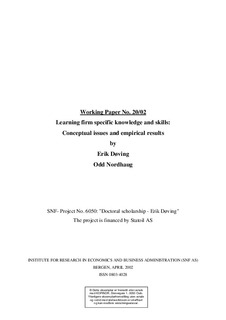| dc.description.abstract | The paper discusses the significance of firm specific knowledge and skills resources among employees, discusses strategies for measurement, and reports the results of an empirical study of learning and competence acquisition. This paper distinguishes between intraorganisational competence and firm-specific technical competence. Intraorganisational competences are the non-task-specific competences related to one particular organization and include knowledge about colleagues, culture, structure, procedures, networks and activities in different parts of the organizations. Firm specific technical competences are task-specific competences related to one particular organization and include skills needed to complete specific tasks in the firm, competences needed to operate or maintain tailor-made equipment, knowledge about firm-specific work-practices and competences related to manufacturing unique products. Until recently the two types of firm-specific competences have not been operationalized for the purpose of self-report survey data collection. A new multi-item, self-report measure was constructed for the purpose of the empirical study reported her. These measures were applied in a study of learning and competence acquisition among 980 managers and professionals in an oil company. The empirical results indicate that cross-unit transfers and extent of communication have large, positive and diminishing effects on intraorganisational competence. The results further indicate that participation in cross-unit task forces and extent of cross-unit communication have positive and diminishing effects on firm specific technical competence. This research demonstrates that different components of firm specific competence can be distinguished empirically and that the two competence types have different antecedents (differential effects). | en |
